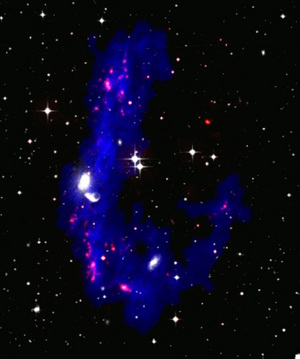Astronomers believe they may have found a significant portion of the universe's "missing" matter.
The mysterious dark matter may be giving invisible heft to small galaxies formed during galactic collisions, a new study says.
Dark matter is an invisible form of matter that does not give off or reflect light yet accounts for the vast majority of mass in the universe.
Scientists measured the mass of three so-called recycled dwarf galaxies near a massive galaxy that was recently in a collision.
The dwarfs appear to be more than twice as heavy as their visible stars and gas, indicating that they hold a type of dark matter.
The finding is a surprise, because theoretical models have suggested that recycled dwarfs should be free of dark matter, according to Frédéric Bournaud, an astrophysicist with the French research agency CEA, who led the new research.
"It is clear that this questions the standard pictures," he said in an email interview.

|
| ©P-A Duc, CEA-CNRS/NRAO/AUI/NSF/NASA
|
| A composite image depicts the galaxy NGC 5291 (white spot left of center) and the surrounding cloud of debris left by its collision with another galaxy 360 million years ago. New research suggests that so-called recycled dwarf galaxies around NGC 5291 (marked in pink) may contain large amounts of "missing" dark matter.
|
Bournaud and colleagues report the finding in the current issue of the journal Science.
Dark Matter TypesDark matter comes in two forms. About 10 percent is composed of undetected ordinary matter - like what makes up you, me, planets, stars, and interstellar gas - called baryonic matter.
The rest is a mysterious material called non-baryonic dark matter, which makes up more than a quarter of the universe.
While little is known about non-baryonic dark matter, recent research suggests it serves as the scaffolding of the universe upon which galaxies are formed.
According to some models, Bournaud explained, galaxies' rotating disks are thought to contain only visible, ordinary matter, while dark matter lies in halos outside the disks.
When galaxies collide, the visible matter inside the disks scatters much faster than the material in the dark matter halos.
Recycled dwarf galaxies form from the scattered blobs created in the collision, so they should therefore be free of dark matter, Bournaud said.
"Only matter from the disks can get into collisional debris and recycled dwarfs," he said.
His new finding thus seems to challenge the standard theory.
Bournaud said the presence of non-baryonic dark matter in the recycled dwarf galaxies would drastically change common understandings of the mysterious stuff.
For starters, it would mean the dark matter resides inside galactic disks, not in the halos. As well, theories of how dark matter holds together the universe would fall apart.
"It is very difficult to change the assumptions on non-baryonic dark matter," Bournaud said.
Missing BaryonsIf Bournaud's theory is correct, the finding would help solve another astronomy mystery: the case of the missing baryonic matter.
When the universe was born some 15 billion years ago, astronomers believe there were about twice as many baryons as are found today.
These undetected bits of ordinary matter are called the "missing baryons."
"One used to think the missing baryons were hot gas, forming diffuse halos around galaxies but not in their disk[s]," Bournaud said.
"We show that at least a large part of these missing baryons is in the disks of galaxies."
Jeremiah Ostriker, an astrophysicist at Princeton University, said Bournaud's study is very interesting but speculative.
The margin of error in the measured mass of the dwarf galaxies is large enough for a skeptic to say they contain no dark matter, he said. Theories on dark matter are still inconclusive, he added, so the dwarf galaxies could contain non-baryonic dark matter.
"These are interesting observations, and they're interesting speculations, but it's not at the level of very conclusive evidence," Ostriker said.
Reader Comments
to our Newsletter